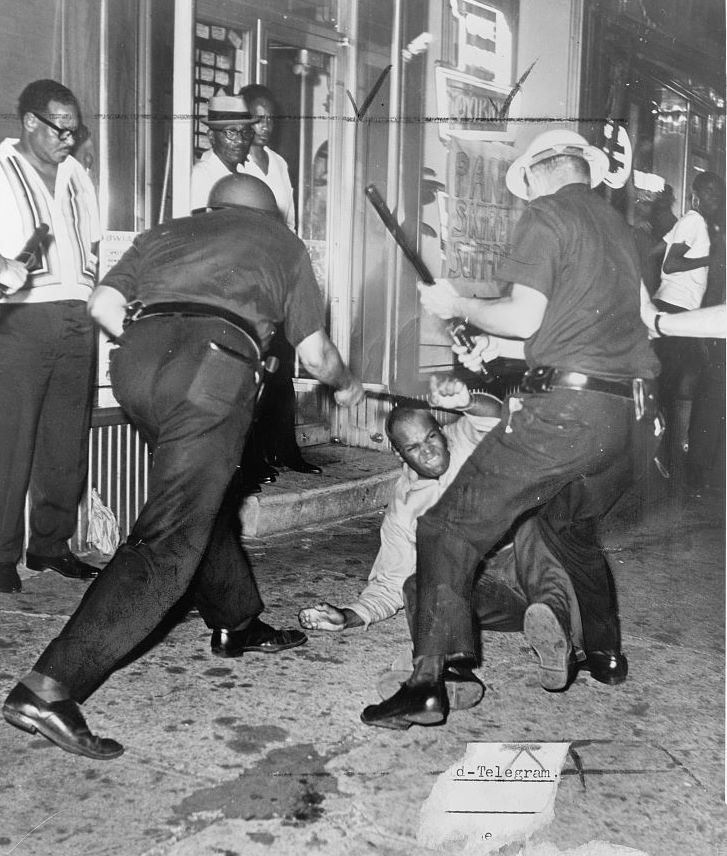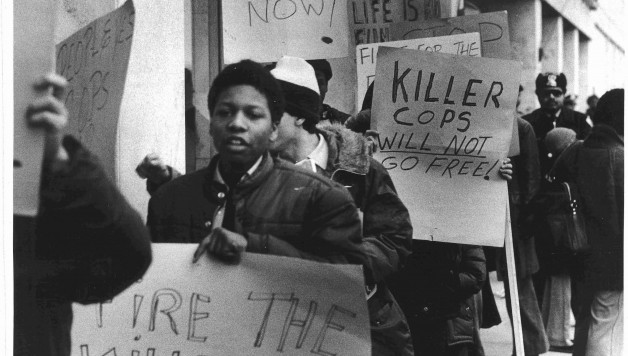Fighting “Stop-and-Frisk” Policing from Rockefeller to Trump

In the latest of Donald Trump’s string of attempts to “court” black voters (clearly aimed at courting his lily-white voter base instead), the Republican presidential candidate answered a question about “black-on-black crime” by suggesting a national stop-and-frisk policing program similar to that ruled unconstitutional in 2013 by a New York federal judge. “I see what’s going on here, I see what’s going on in Chicago,” Trump said, “I think stop and frisk, in New York City, it was so incredible, the way it worked . . . So I think that would be one step you could do.” The talk, which was set to air Wednesday night, was postponed due to the protests in Charlotte following the death of Keith Lamont Scott, which was likely a result of the sort of racial profiling suggested by Trump.
The scene of a wealthy white Republican man suggesting these tactics amidst urban uprisings against police violence conjures the very origins of New York’s stop-and-frisk by Nelson Rockefeller in 1964. It should also remind us of the groundswell of grassroots resistance to such measures by black activists, which complicates the “black silent majority” sign-off suggested by Michael Fortner in his recent book by the same name. Rockefeller’s crime bill, an antecedent to the more notorious Rockefeller drug laws a decade later—which Fortner calls the black silent majority’s “greatest legislative victory”—was in fact vehemently opposed by Harlem citizens and local civil rights organizers.

In March 1964, Rockefeller signed a bill which introduced stop-and-frisk police tactics and a new “no-knock” policy by which law enforcement could enter residences without giving notice. The stop-and-frisk would permit police to detain any citizen “reasonably” suspected of having committed a crime.1 As pointed out by Brian Purnell, this language is reflected in the 1989 Graham v. Connor decision of “objective reasonableness,” which asserts that arrests which do not meet this “reasonableness” violate the Fourth Amendment. Support for the bill did not come from clergymen, civil rights leaders, or ordinary black citizens, but from law-enforcement: police chiefs, state police, district attorneys, and sheriffs. The bill used crime in black communities to justify more violence against them. As Gil Scott-Heron later explained, “No Knock, the law in particular, was allegedly legislated for black people rather than—you know—for their destruction.”
Black New Yorkers unequivocally denounced these tactics. Local NAACP and CORE chapters threatened to demonstrate outside Rockefeller’s office before he’d even signed the bill into law. A coalition of twenty organizations and leaders called for him to veto the bill and pressed for the establishment of a citizen review board to oversee police practices. Opposition came not only from activist camps, but from ordinary citizens. As one letter to the editor in the Amsterdam News noted: by “signing the so called ‘no knock’ bill and the ‘stop and frisk’ bill the governor is virtually giving this type of policeman a green light to go ahead and do his work. We agree with the civil rights groups who have joined to fight this legislation. It must not stand.”2

Meanwhile, a group of veteran activists in Harlem had been gathering in the apartment of a young Los Angeles transplant, Lynne Shifflett, to join Malcolm X in producing his first independent black political organization since he left the Nation of Islam earlier that year.3 Led by John Henrik Clarke, John Oliver Killens, Ruby Dee, Ossie Davis, and young writers Peter Bailey, Sara Mitchell, and Shifflett, the group that would soon become known as the Organization of Afro-American Unity (OAAU) immediately designated the “no knock” bill as its primary action project. The organization planned to set up a 24-hour telephone hotline to record police abuses and outlined a symbolic funeral down 125th Street with a casket symbolizing their “intention to bury the ‘No Knock’ law.”4 As the bill was set to go in effect that summer, protest against it grew. The Harlem Lawyers Association argued the unconstitutionality of the bill and threatened to bring forth a case. Attorney Cora Walker called it a “tragedy that our police force must be armed with such a weapon in order to deal with problems which we all know are socio-economic and cannot be solved in this matter.”5
Just weeks into the new police order established by Rockefeller’s bill, Harlem erupted following the murder of unarmed 15-year-old James Powell in front of his friends by white police officer Thomas Gilligan. After a week of insurgence, nearly five hundred were injured, one man was dead, and Harlem had suffered nearly $1 million in property damage. The OAAU’s newsletter expressed its outrage: “No one in his wildest dreams can imagine a black policeman shooting and killing a 15 year old white boy without losing job and possibly his life. Yet a white cop brazenly shot down an Afro-American boy without even being suspended.”6 Contrary to the idea that activists were simply concerned with fewer police and not the practice of policing, the paper also reminded readers that critiques of police were not the same as remaining unconcerned about crime within black communities. “Those public officials and downtown newspapers who are constantly screaming for law and order are trying to make us think that the two words go hand-in-hand,” its newsletter opined. “What they want is order first and maybe law second. No one knows better than the Afro-Americans that you can have plenty of order without having much law, especially law enforcement.”7

Trump has followed the blueprint of law-and-order Republicans—from Rockefeller to Nixon—by continuing to suggest that crime in black communities is a problem of the people in those communities rather than one produced by the white supremacy for which he is the willing figurehead. As Trump sat grinning behind Don King in Cleveland, I was reminded of Malcolm X’s words about Rockefeller and the crime bill that summer of 1964:
Rockefeller with his old smile, always he has a greasy smile on his face and he’s shaking hands with Negroes, like he’s the Negro’s pappy or granddaddy or great-uncle. Yet when it comes to passing a law that is worse than any law that they had in Nazi Germany, why, Rockefeller couldn’t wait till he got his signature on it. And the only thing this law is designed to do is make legal what they’ve been doing all the time.8
But, whether or not Don King wants to stand up as the black vocal minority, there is no black silent majority endorsing Trump or this latest iteration of Rockefeller’s drug laws. And before calling for another era of “stop-and-frisk,” Trump might want to listen to Gil Scott-Heron first:
No knockin’, head rockin’, inter-shockin’
Shootin’, cussin’, killin’, cryin’, lyin’
And bein’ whiteBut if you’re wise, no knocker
You’ll tell your no-knockin’ lackeys
Ha!
No knock on my brother’s head
No knock on my sister’s head
No knock on my brother’s head
No knock on my sister’s headAnd double lock your door
Because soon someone may be no-knockin’
Ha, ha!
For you
Garrett Felber is a scholar of 20th-century African American history at the University of Michigan in the American Culture Department. His scholarship has been published in the Journal of African American History, South African Music Studies, and SOULS. He has also contributed to The Guardian, The Marshall Project, and Viewpoint Magazine. Follow him on Twitter @garrett_felber.
- Douglas Dales, “Rockefeller Signs Bills Increasing Powers of Police,” New York Times, March 4, 1964. ↩
- “A Bad Law,” Amsterdam News, March 7, 1964. ↩
- For more on the OAAU’s community organizing, see my article “Harlem is the Black World: The Organization of Afro-American Unity at the Grassroots,” The Journal of African-American History 100.2 (Spring 2015): 199–225. ↩
- Working Papers, June 6, 1964, Box 14, Folder 3, Malcolm X Collection, Schomburg Center for Research in Black Culture. ↩
- “Harlem Warns City on Stop Frisk Law,” Amsterdam News, July 4, 1964. ↩
- “A Divided People Will be Crushed,” OAAU Newsletter, August 3, 1964. ↩
- “More Law Enforcement or Less Order,” ibid. ↩
- Malcolm X, “OAAU Statement of Basic Aims and Objectives,” By Any Means Necessary (New York: Pathfinder Press, 1992), 51. ↩
